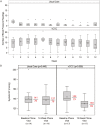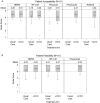Implementing a home-based virtual hypertension programme-a pilot feasibility study
- PMID: 35994031
- PMCID: PMC10047620
- DOI: 10.1093/fampra/cmac084
Implementing a home-based virtual hypertension programme-a pilot feasibility study
Abstract
Introduction: Implementing a health system-based hypertension programme may lower blood pressure (BP).
Methods: We performed a randomized, controlled pilot study to assess feasibility, acceptability, and safety of a home-based virtual hypertension programme integrating evidence-based strategies to overcome current barriers to BP control. Trained clinical pharmacists staffed the virtual collaborative care clinic (vCCC) to remotely manage hypertension using a BP dashboard and phone "visits" to monitor BP, adherence, side effects of medications, and prescribe anti-hypertensives. Patients with uncontrolled hypertension were identified via electronic health records. Enrolled patients were randomized to either vCCC or usual care for 3 months. We assessed patients' home BP monitoring behaviour, and patients', physicians', and pharmacists' perspectives on feasibility and acceptability of individual programme components.
Results: Thirty-one patients (vCCC = 17, usual care = 14) from six physician clinics completed the pilot study. After 3 months, average BP decreased in the vCCC arm (P = 0.01), but not in the control arm (P = 0.45). The vCCC participants measured BP more (9.9 vs. 1.2 per week, P < 0.001). There were no intervention-related adverse events. Participating physicians (n = 6), pharmacists (n = 5), and patients (n = 31) rated all programme components with average scores of >4.0, a pre-specified benchmark. Nine adaptations in vCCC design and delivery were made based on potential barriers to implementing the programme and suggestions.
Conclusion: A home-based virtual hypertension programme using team-based care, technology, and a logical integration of evidence-based strategies is safe, acceptable, and feasible to intended users. These pilot data support studies to assess the effectiveness of this programme at a larger scale.
Keywords: geriatrics; hypertension (high blood pressure); patient adherence; patient education; primary care; self-management; telemedicine.
© The Author(s) 2022. Published by Oxford University Press.
Conflict of interest statement
None declared.
Figures



References
-
- Whelton Paul K, Carey Robert M, Aronow Wilbert S, Casey Donald E, Collins Karen J, Dennison Himmelfarb C, DePalma Sondra M, Gidding S, Jamerson Kenneth A, Jones Daniel W, et al. . 2017 ACC/AHA/AAPA/ABC/ACPM/AGS/APhA/ASH/ASPC/NMA/PCNA Guideline for the prevention, detection, evaluation, and management of high blood pressure in adults: a report of the American College of Cardiology/American Heart Association Task Force on Clinical Practice Guidelines. Hypertension. 2018;71(6):e13–e115. - PubMed
-
- Bress AP, Kramer H, Khatib R, Beddhu S, Cheung AK, Hess R, Bansal VK, Cao G, Yee J, Moran AE, et al. . Potential deaths averted and serious adverse events incurred from adoption of the SPRINT (Systolic Blood Pressure Intervention Trial) intensive blood pressure regimen in the United States: projections from NHANES (National Health and Nutrition Examination Survey). Circulation. 2017;135(17):1617–1628. - PMC - PubMed
-
- Whelton PK, Carey RM, Aronow WS, Casey DE, Collins KJ, Dennison Himmelfarb C, DePalma SM, Gidding S, Jamerson KA, Jones DW.. 2017 ACC/AHA/AAPA/ABC/ACPM/AGS/APhA/ASH/ASPC/NMA/PCNA Guideline for the prevention, detection, evaluation, and management of high blood pressure in adults: a report of the American College of Cardiology/American Heart Association Task Force on Clinical Practice Guidelines. J Am Coll Cardiol. 2018;71(19):e127–e248. - PubMed
Publication types
MeSH terms
Substances
Grants and funding
LinkOut - more resources
Full Text Sources
Medical

